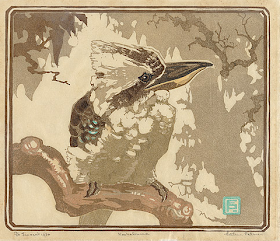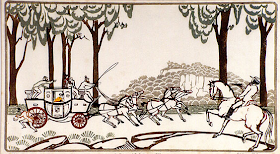It's all been said before about Ethleen Palmer, 'Oh, that one reminds me of someone or other', so it's a routine I'm going to try and avoid simply because it detracts from Palmer when she is at her best. And when she is on form, as she was with her Kookaburra, her best was pretty good. This will also be very much a personal selection from her work. I much prefer her earlier linocuts to her later screeprints, which I think come across as brittle by comparison - online, at least. But then, that is where most people are going to see her prints.
I gather she spent her childhood in various places in the Far East with her travelling parents, where her mother picked up oriental art as she went along. So, she was probably predisposed, when she at last arrived in Australia at the age of fourteen, to be as alert and observant when it came to her new habitat as the true natives you see here. That she was alert is beyond doubt. She knew that to be too representational would be fussy and fatal when it came to a medium as fluid as lino, that she needed to select as much as to describe. That she can get this balance right is one of her strengths.
And speaking of highway robbery, the images here, that were largely lifted from the National Gallery of Australia, are in reasonably good condition (though not always), but what I do notice about some of the others by her that I see around is how many of them are stained and foxed in the margins, and to carry on with the discussion about condition, when it comes to buying Palmer as opposed to just reading about her, it seems one must be realistic in one's expectations, hint, hint.
At least with Palmer we are by large spared the outlandishness of the Grosvenor School and its Australian contingent. More like Allen Seaby she relates animals to their habitat with deftness. The cliffs behind the pair of sturdy-looking horses are quite magnificent in themselves. She is nimble when she could have been self-conscious. If the interaction of her subjects veers towards sentiment on occasions, well, we can forgive her because she's good.







You've lived and studied in Sydney and know the Australian scene alot better than I do. I just dip my toe in the Pacific now and then. But from a British angle, the "other" Australians have suffered partly as a result of the unnecessary interest in Hall Thorpe and the Grosvenor Gang, largely dealer-led.
ReplyDeleteOne of the good things about the Canadian and Australian artists is that they had the chanxce of a career after the war. Where would Sybil Andrews have been if she had stayed in the UK?
Ethleen Palmer was a relative of mine. I have been 'collecting' her works from the internet as well as acquiring a small collection. Her output of work was enormous and I have noticed that there has never been a publication showing her work, apart from the odd review. As part of our family history collection I have compiled a portfolio of many of her works. The portfolio has been added to the National library of Australia edepository and can also be access from the link below, should anyone be interested.
ReplyDeletehttps://www.dropbox.com/s/w9gxuqb66va5azw/Ethleen%20Palmer%20-%20A%20portfolio%20%20.pdf?dl=0